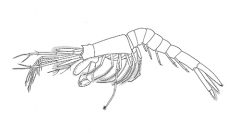

 European Journal of Taxonomy
2020 (628) - Pages 1-43
European Journal of Taxonomy
2020 (628) - Pages 1-43Three species of Lophogastrida and eight Mysida are documented for samples from 5161–5497 m bottom depth in the Angola Basin. Previously known latitudinal ranges are extended southward for five species, and bathymetric ranges extended beyond 5000 m for six species. Upon revision of the subfamily Petalophthalminae (Mysidae), four species previously attributed to the genus Petalophthalmus are integrated into Ipirophthalmus gen. nov. as I. liui gen. et comb. nov., I. caribbeanus gen. et comb. nov., I. oculatus gen. et comb. nov., and I. macrops gen. et comb. nov., mainly based on the structure of eyes and presence of setae on the telson. Petalophthalmus cristatus sp. nov. is described based on its reduced cornea and the structure of eyestalks, rostrum, mandibles, and telson. The structure of mouthparts, foregut and maxillipeds suggests an omnivorous mode of life. The diagnosis of the tribe Calyptommini (Mysidae: Erythropinae) is widened to cover the 3-segmented, uniramous fourth male pleopod and the non-incised eyeplate with horn-like rudiments of eyestalks in Abyssomysis cornuta gen. et sp. nov. The structure of mandibles, foregut, and second maxilliped suggest detritus feeding in this species. Keys to the Calyptommini and Petalophthalminae are given.
Taxonomic revision, first description, biogeography, abyssal zone, equatorial East Atlantic